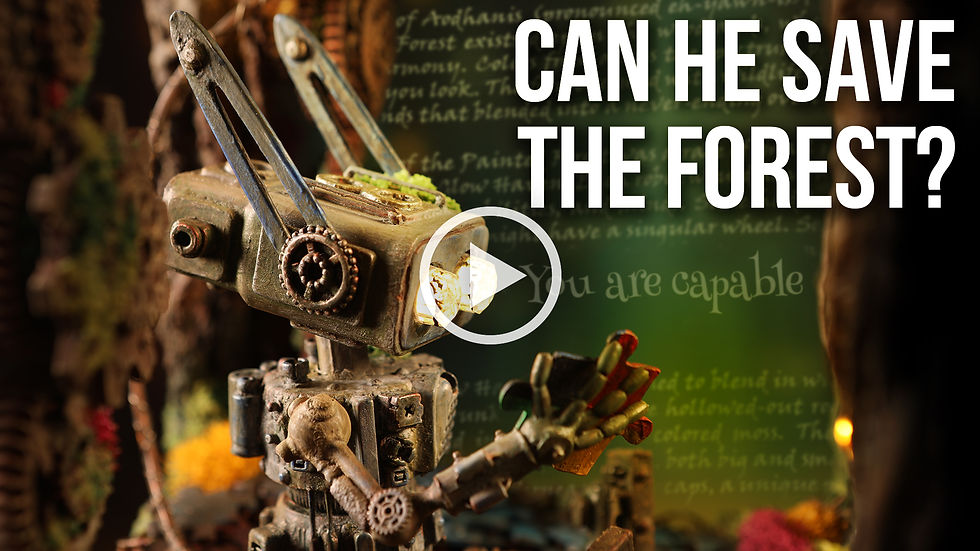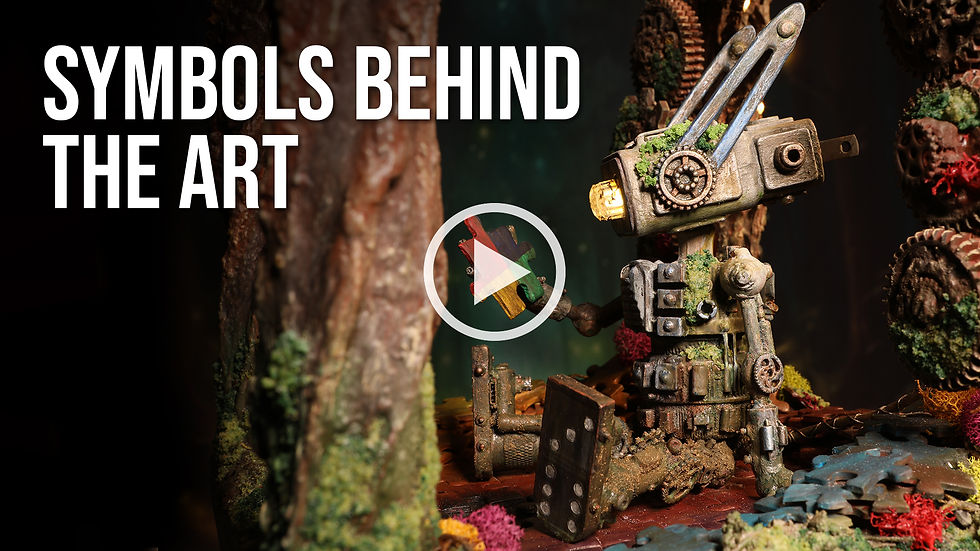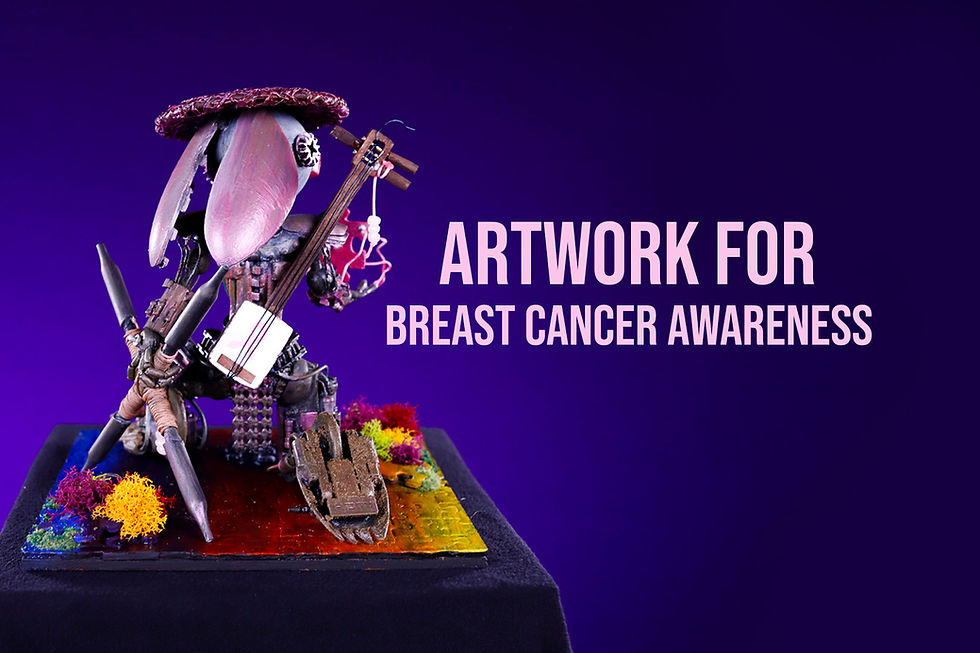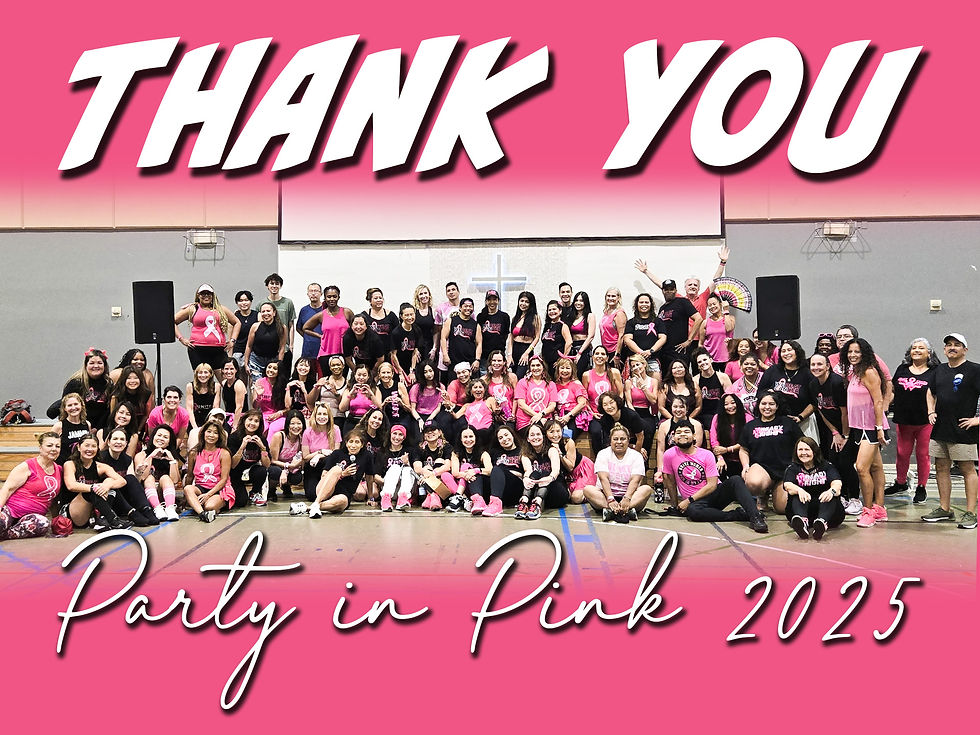Artwork for Autism Awareness - The Robot, the Butterfly, and the Lantern
- Jeremy Ramos

- Apr 29
- 6 min read
Updated: Nov 14
The Story
The story of Puzz-L the Capable, a neurodivergent robot that saves a dying forest, is chronicled in a diorama called "The Robot, the Butterfly, and the Lantern." The main purpose of this piece is to create dialogue and awareness regarding autism (ASD - Autism Spectrum Disorder), the widelook range of people that it can affect, from both children and adults, and the varying degrees of ASD that people may have.
Or read the short story here:
Support our Autism Awareness Fundraising Campaign
for the Autism Research Institute
The Jam Diego Outreach Program is collecting funds to support the Autism Research Institute. 100% of the funds collected will be donated.
To donate directly to our fundraising campaign, please visit this link: https://donorbox.org/jamdiegoautism25
A 150-Day Awareness Experience
The whole project took 150 days to complete. What initially started as a simple robot build grew into something much bigger that stretched my creative abilities, knowledge, and awareness. My background as a graphic designer brought visual sensitivity to the project, but for the last two decades, I have only worked on a computer screen through a keyboard and mouse. I felt confident in constructing most of the piece, but making a concept come to life through a paintbrush was something I was not very experienced with. The painting process felt more like trial and error as I grew my understanding of how to achieve a certain look. On top of that, learning how to incorporate motors into this piece with moving parts is something that I have never tried before.
Check out this gallery that highlights the creative process.
Most importantly, I learned so much about Autism during my 150-day awareness experience. Initially, my default image of an autistic person usually consists of the tragic portrayal of children with severe conditions seen in autism fundraising commercials. After many hours of research, talking with family members of people with autism, and reading through the stories of people in the autistic community, it is crucial to remember that Autism Spectrum Disorder includes a very wide variety of people, both children and adults, that have varying degrees of autism ranging from highly functional to severely challenged. I have also learned new terminology, the three levels of severity, different symbols representing autism, and the main reason why the rates of autism have increased significantly over the years.
I also had an opportunity to talk with an adult, who seems like she has no intellectual or social challenges, who just learned a few months ago that she was on the spectrum. She explained that she is a highly functioning individual with autism and that her diagnosis explained a lot of life experiences where she missed vital social cues. Her story also highlights the idea that there can be individuals out there who do not realize that they are living with autism. Based on the variety of physiological differences seen in people around the world, it's not hard to see that a wide range of neurological differences can exist as well.
Creating Dialogue with the Symbols Representing Autism
I started this project with the puzzle piece, the 1st and most widely known symbol representing autism that I was familiar with, as a main focus for the artwork. My vision was to have a robot sitting on a floor made out of a jigsaw puzzle that had one piece missing, and the robot was holding the missing piece in his hand. I soon learned that the butterfly was another symbol that was used to represent autism, and I thought it would be super cool to have that incorporated into the piece, and better yet, actually have the wings move. About halfway through the project, when everything was mostly built, a friend messaged me about a post that another friend published on social media. This post identified that the symbol of the puzzle piece is considered offensive to most people in the autistic community and that the infinity symbol should be used instead. This was puzzling to me as I was showing previews of the work that I have done, and people who are in the autistic community loved the puzzle piece. I delved into the history of these symbols and learned that the autistic community is divided on all the symbols, and the reasons why are completely understandable. I felt that the symbols and the various degrees of acceptance and rejection of them were a great dialogue piece, and all three had to be represented in the artwork.
Here are the three main symbols used to represent autism and some of the main reasons why they are embraced or rejected:
The Puzzle Piece (established in 1963): Originally intended to symbolize the "puzzling" nature of autism and the diverse experienced of autistic people. The symbol can be seen as problematic with some autistic individuals viewing it as autism is something that needs to be fixed or cured. There is also an association of the puzzle piece to the "Light It Up Blue" campaign by the organization "Autism Speaks," where their goal is to find a cure for autism. Another reason why the symbol is rejected is that some people feel like it makes autism infantile and doesn't represent the adult population. People with autism who embrace the puzzle piece view the symbol as a challenge to find understanding or to find one's strengths.
The Gold Infinity Symbol (established in 2005): The gold infinity symbol (for autism) or rainbow infinity symbol (for neurodiversity) is used to represent the idea of acceptance, that the infinite possibilities of autistic individuals and the diverse spectrum of experiences is something that doesn't need to be fixed, but to be accepted and celebrated. The gold color is also associated with the chemical symbol for gold (Au), which is the connection to the word "Autism." People who reject the gold infinity symbol feel that it's too singular and straight forward, that Autism is simple and not diverse or complex. Others felt that the gold color is pretentious, and they don't want to be seen as "special." Another comment on the gold infinity symbol that stood out to me is that, "It's weird that you have to connect the chemical symbol for gold (Au) to make the connection to autism. It shouldn't feel like a 'puzzle' to figure out."
The Butterfly (established in 2024?): The butterfly is used to symbolize transformation and growth, hope, and continual development. This is a relatively new symbol for autism and has not yet been universally adopted. One reason that the symbol is rejected is that some people feel like it also makes autism infantile and doesn't represent the adult population.
The response to each symbol highlights that the wants and needs for people with autism are so wide and diverse. It makes sense that each person will have their unique perspective and experience that can explain the acceptance or rejection of the currently established symbols for autism, which is completely human.
Other personal symbols that I have added to this piece are the following:
Dominoes with Numbers 1, 3, and 6: The numbers represent that 1 out of 36 children are diagnosed with ASD. While working on the project, the CDC announced on April 15, 2025, that new data indicate that 1 out of 31 children are now diagnosed with ASD in the United States.
The Lantern: The structure of the diorama is a lantern, representing a light to reveal a path. That pathway could be a road to understanding, acceptance, the means to find one's strengths, continual development, etc.
Gears: Gears are used to represent the inner workings of the mind, as ASD is a neurological disorder.
Variety of Vibrant Colors: The vibrant colors used in this piece represent neurodiversity that covers a whole spectrum.
A Few Terms You Should Know About Autism
There are some basic terms along with their abbreviations that kept on popping up on social media posts and comments that I wasn't familiar with that are used regularly.
Autism Spectrum Disorder (ASD) - The medical term for autism, encompassing a range of conditions affecting social interaction, communication, and behavior.
Neurotypical (NT) - Refers to individuals who do not have autism or other neurodevelopmental differences.
Neurodivergent (ND) - Used to describe individuals with autism or other neurodevelopmental differences.
The 3 Levels of Autism
Autism Spectrum Disorder (ASD) is characterized by different levels of support needed, ranging from mild to very substantial. The DSM-5 (Diagnostic and Statistical Manual of Mental Disorders, Fifth Edition) describe the three as the following:
Level 1: Requiring Support
Individuals at this level need some support in daily life, particularly with social interactions and organization.
They may have difficulty initiating social interactions and understanding social cues.
They may also have trouble with planning and organization.
This level is sometimes referred to as "high-functioning" autism.
Level 2: Requiring Substantial Support
Individuals at this level require more substantial support for social interaction and communication.
They may have trouble with both verbal and nonverbal communication, and may struggle to understand social cues.
They may also exhibit more pronounced difficulties with repetitive behaviors and restricted interests.
Level 3: Requiring Very Substantial Support
Individuals at this level need very substantial support in all areas of life, including social interaction, communication, and daily living skills.
They may have limited ability to communicate and interact with others, and may have significant challenges with self-care and daily tasks.
This level is considered the most severe form of autism.
































































































































Comments